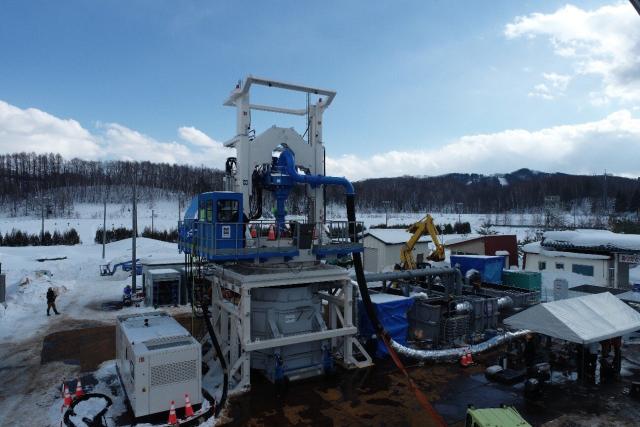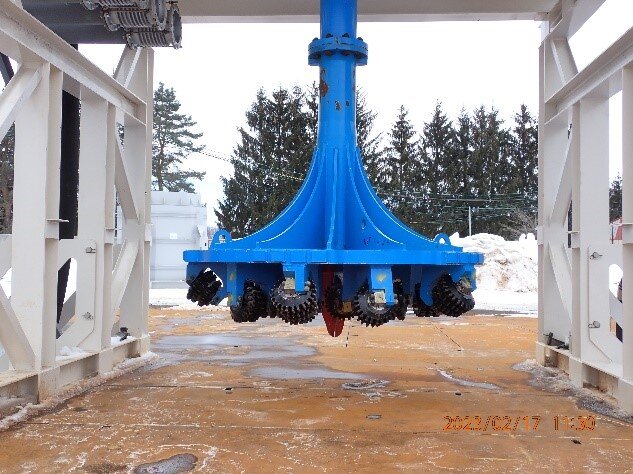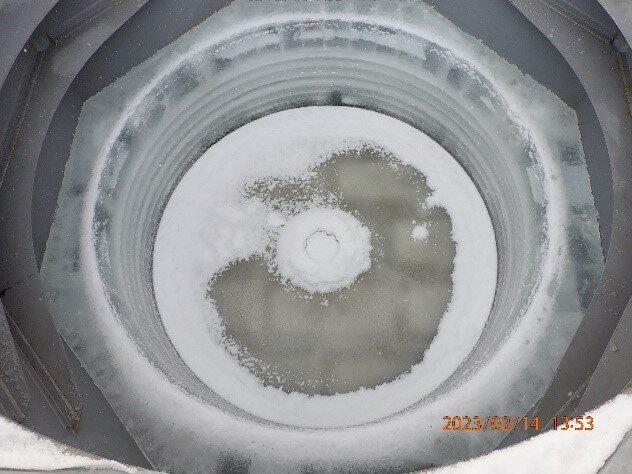
The equipment used for the methane hydrates drilling test earlier this year. (Source: MODEC)
Onshore tests funded by the Japanese government have moved forward the technology needed to exploit methane hydrates, known as fiery ice, locked inside sandstone in offshore environments.
FPSO company MODEC is providing the engineering on floaters being used in the shallow methane hydrates project that is backed by Japan. MODEC is also working with subsea diamond mining company HMH to develop a drilling system capable of harvesting methane hydrates. Further development on the project is expected to start in the next fiscal year.
“This is similar to our major FPSO business for the oil and gas industry,” Hiroaki Yokota, MODEC general manager, said. “We tried to use the existing FPSO technologies for shallow methane hydrate harvesting.”
The shallow methane hydrate harvesting system would run from a floating production system with a drilling derrick. The large diameter drill and riser system would suck up cuttings along with seawater, which would prevent an operational plume from occurring, said Shunsuke Iwamoto, a MODEC engineer. The methane hydrates, cuttings, seawater and methane gas would flow up the riser to a gasification tank on the floating production system. Resulting methane gas would be sent through a subsea pipeline to onshore plants, while slurry would be discharged back into the seabed.
For more than five years, the Japanese government has been focused on finding a way to harvest the shallow methane hydrates present in its national waters.
Iwamoto noted that methane hydrates exist offshore Japan in sandstone layers of the seabed in water depths of about 1,000 m and that shallow methane hydrates exist in areas of about 500 m water depth.
“The Japanese government wants to develop both types and use them as a resource of hydrogen or ammonia,” he said. The resulting hydrates would “supply energy stably, without risks from geopolitics.”
The National Institute of Advanced Industrial Science and Technology (AIST) has been commissioned by the Ministry of Economy, Trade and Industry (METI) to develop the methane hydrate harvesting technology. The method of choice called for a vertical drilling method with disk-shaped, large diameter drill bits.
“We developed the drilling system based on an existing system with HMH, which has been in commercial diamond subsea mining,” Iwamoto said.
‘A beautiful hole’
The drilling system uses Wirth Reverse Circulation Drilling. Iwamoto said the system was chosen because it prevents an operational plume during drilling. It also works in both soft seabed and complicated terrains, such as inclines.
Questions arose about which kind of cutter was most suitable for mining methane hydrates and how well the drill bit performed. Before taking the equipment offshore, the bit was tested earlier this year in two types of simulated methane hydrate ground.

The first test used 20% polypropylene balls to simulate granular methane hydrates mixed in with 80% fluidized soil — giving it almost the same strength as mud from a seabed containing granular methane hydrates. That test, carried out in October 2022, was focused on confirming the ability to harvest small, granular methane hydrates.
In a second test, a solid ice block with nearly the same strength as a methane hydrate block was drilled. This test, carried out over six days of drilling earlier this year at the Kitami Institute of Technology (KIT), focused on gathering performance data on three different kinds of drilling cutters.
MODEC installed four steel tanks with a diameter of about 3 m and created ice about 1 m thick in order to simulate 100% content of shallow methane hydrate ground. Researchers naturally accumulated the ice through layering and integrating commercial ice and water.
“We checked many parameters for the cutters,” including drilling speed and ROP and compared the data for each, Iwamoto said.

The system delivered a solid performance in both tests.
“We confirmed the drilling system had very good performance for drilling in simulated methane hydrate ground,” Iwamoto said. “It made a very beautiful hole.”
MODEC said the next step is to optimize the combination of drill bits and equipment for use in different conditions. Additional tests will simulate the required power and drilling capacity to confirm the effectiveness and economics of the harvesting approach.
When—or if—an offshore test will occur remains up to the Japanese government, Yokota said.
He said the preliminary technology still needs additional study and testing before it can be commercialized. The Japanese government will decide the contents of the next phase of shallow methane hydrate development this year and that the work will start in the next fiscal year, said Yokota.
According to a roadmap for the project prepared by the Japanese government, commercialization could occur around the 2027 fiscal year.
Recommended Reading
Green Swan Seeks US Financing for Global Decarbonization Projects
2024-02-21 - Green Swan, an investment platform seeking to provide capital to countries signed on to the Paris Agreement, is courting U.S. investors to fund decarbonization projects in countries including Iran and Venezuela, its executives told Hart Energy.
BP Pursues ‘25-by-‘25’ Target to Amp Up LNG Production
2024-02-15 - BP wants to boost its LNG portfolio to 25 mtpa by 2025 under a plan dubbed “25-by-25,” upping its portfolio by 9% compared to 2023, CEO Murray Auchincloss said during the company’s webcast with analysts.
Sunoco’s $7B Acquisition of NuStar Evades Further FTC Scrutiny
2024-04-09 - The waiting period under the Hart-Scott-Rodino Antitrust Improvements Act for Sunoco’s pending acquisition of NuStar Energy has expired, bringing the deal one step closer to completion.
Battalion in Compliance with NYSE American after 2023 Meeting
2024-02-13 - Previously, Battalion Oil was not in compliance with the NYSE after failing to hold an annual meeting of stockholders during the fiscal year ending Dec. 31.
JMR Services, A-Plus P&A to Merge Companies
2024-03-05 - The combined organization will operate under JMR Services and aims to become the largest pure-play plug and abandonment company in the nation.






